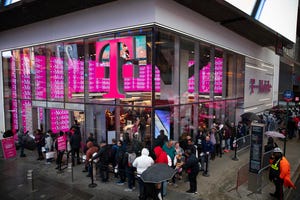Telcos Give Vent to Edge-Computing Anxiety
Operator anxiety about the rollout of edge-computing technology could see them lose another battle to the web-scale giants.

MUNICH -- Mobile Edge Computing Congress -- Several of the world's largest telcos, including Deutsche Telekom, Orange and Vodafone, have raised fresh concerns about the business case for network edge computing, despite industry consensus on the ultimate need for a distributed cloud architecture.
Executives gathered at this week's Mobile Edge Computing Congress in Munich have voiced fears about the cost implications of building mobile edge networks, and whether these will spur much revenue growth in the future.
Technology proponents argue that moving compute-and-storage capabilities closer to users -- and so becoming less reliant on centralized data center facilities -- would lead to performance improvements and open up new service and revenue opportunities. Ultimately, it could give telcos a key advantage over cloud providers operating more centralized infrastructure.
The danger is that those same cloud providers might seize the edge-computing initiative while operators wrestle with a range of deployment challenges.
"From what I understand, Google is pretty keen on [edge computing]," says Gabriel Brown, a senior analyst with the Heavy Reading market research business. "If they could get access to it at the right price, I think they would use it."
As Brown points out, Google (Nasdaq: GOOG) currently lacks much access infrastructure. Its Google Fiber Inc. subsidiary, however, has been rolling out high-speed fiber networks in parts of the US that could hint at edge-computing ambitions.
While many analysts think Google Fiber is designed mainly to explore new service possibilities and spur broadband investment by others, the infrastructure that supports a fiber broadband rollout could prove invaluable in a distributed cloud environment. Google Fiber has also recently turned its attention to fixed-wireless access technologies as a means of providing broadband connectivity. (See Google Looks to Test 3.5GHz Broadband Radios and Google Fiber May Go Wireless in the Valley – Report.)
Intriguingly, Google is due to make a presentation at the MEC Congress Thursday on using mobile edge computing "to connect the next billion."
Currently the world's second-biggest company by market capitalization -- behind Apple Inc. (Nasdaq: AAPL) -- Google clearly has the financial clout to shoulder the investment burden of deploying edge computing assets at scale.
The same cannot necessarily be said of telcos that continue to report revenue stagnation amid regulatory and competitive challenges.
"It's all about the money," said Franz Seiser, the vice president of core networks and services for German incumbent Deutsche Telekom AG (NYSE: DT), when asked about the edge-computing "roadblocks" during a panel session in Munich earlier this week.
"On the spending side, it's not very cost efficient to cover the network with computing capabilities that can reach any device in less than a millisecond," he told attendees at the MEC Congress.
At first, telcos are likely to roll out edge-computing networks in specific locations, such as shopping malls and sports stadiums, installing servers at "aggregation points," rather than at mobile basestations, in order to contain costs.
Even so, Deutsche Telekom is also concerned that telcos pursuing different approaches will find it hard to attract the interest of application developers.
"On the earnings side, once we have the platform, who will be using it?" said Seiser. "The operator tradition is that we each do things slightly differently and that is not what motivates application developers. This is one reason our OTT [over-the-top] friends are so successful -- they don't try to optimize for one specific network."
Want to know more about cloud services? Check out our dedicated cloud services content channel here on Light Reading.
Specifications group European Telecommunications Standards Institute (ETSI) is working on the development of open application programming interfaces (APIs) in an effort to lure application developers, but representatives of other operators are equally concerned. (See ETSI Gets Edgy About Mobile.)
"Incentivizing app developers is a challenge," said Guenter Klas, a researcher at Vodafone Group plc (NYSE: VOD). "Several parties in the industry are trying to bridge the gap with application developers but there should be more of those initiatives to allow developers to try things out."
Gerhard Fettweis, the Vodafone chair professor at the Technical University of Dresden, similarly frets that communications service providers might not profit from edge-computing investments.
"Who will earn money on the MEC [mobile edge computing] network?" he asks. "Is it the operator or some compute server provider, like Akamai? The business side is unclear."
France's Orange (NYSE: FTE), meanwhile, seems worried that current mobile edge computing proposals will eventually be swept aside by 5G realities. "There is a big question about the timeframe of the MEC proposal," said Rida Zouaoui, Orange's head of access networks standardization. "Will it be possible before the 5G people define a different way of achieving this?"
ETSI's mobile edge computing ISG (industry specifications group) insists that it is collaborating with the 3rd Generation Partnership Project (3GPP) to make sure its own work feeds into 5G standards development. Yet there is evidently unease about the overlap between ETSI and other groups addressing the edge-computing topic.
One issue is how ETSI's mobile edge computing ISG maps to network functions virtualization (NFV), whereby operators run network functions as software programs on commodity hardware.
Indeed, a separate ETSI ISG is defining specifications for NFV, raising the troubling possibility that two separate management and orchestration systems eventually take shape.
ETSI says it is addressing this risk by aligning the efforts of the two separate groups but admits there is still work to be done in this area.
It is also formalizing agreements with other associations working on edge computing, including Open Edge Computing and OpenFog, and changing the name of its ISG to "multi-access edge computing" as it broadens its remit to include unlicensed wireless access technologies such as WiFi and even fixed access technologies. (See ETSI Drops 'Mobile' From MEC.)
What remains in doubt is whether ETSI is seen as the entity best placed to steer edge-computing standardization. ETSI is quick to note that neither Open Edge Computing nor OpenFog are specifications groups. Yet while membership of its ISG includes most western European telco incumbents, and a number of leading vendors, it is missing major names, such as Sweden's Ericsson AB (Nasdaq: ERIC) and Deutsche Telekom.
The German operator recently told Light Reading that it had a "broader view" of edge computing than MEC. "We believe in edge computing that is independent of the access," said a spokesperson.
Industry observers will be interested to see if the broader remit of the ETSI's MEC group will prompt a change of heart within Deutsche Telekom.
— Iain Morris, 

 , News Editor, Light Reading
, News Editor, Light Reading
Read more about:
EuropeAbout the Author(s)
You May Also Like












